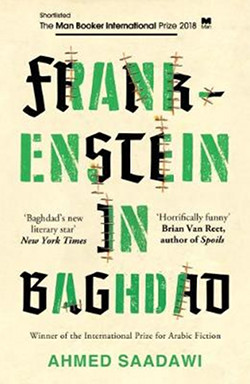Reworking A Classic: Frankenstein in Baghdad by Ahmed Saadawi
 The Arabic world has seen an upsurge in speculative fiction in recent years. Some attribute it to the disappointments of the Arab Spring and the disaster of the U.S. invasion of Iraq. Others point to ready access to the Internet, allowing Arab writers to communicate more easily with genre fans in other parts of the world.
The Arabic world has seen an upsurge in speculative fiction in recent years. Some attribute it to the disappointments of the Arab Spring and the disaster of the U.S. invasion of Iraq. Others point to ready access to the Internet, allowing Arab writers to communicate more easily with genre fans in other parts of the world.
Of course this ignores the fact that Arabic literature has a long tradition of the fantastic. Arab writers are working from very deep roots. So it’s interesting that one of the most successful Arab speculative novels of the past decade takes its inspiration from a Western source.
Frankenstein in Baghdad retells Mary Shelley’s classic tale in American-occupied Baghdad in the early years of this decade. The book originally came out in Arabic in 2013. Baghdad is a nightmare of opposing factions shooting it out while a corrupt Iraqi government propped up by the clueless Americans tries to keep it all together.
***Spoilers follow. If you don’t like spoilers, just go out and buy the novel. You’ll be glad you did.***
Hadi is a junk dealer who drinks too much and works too little, living in an abandoned house and telling wild tales at the local cafe to anyone who listens. On his rounds he comes across the wreckage of countless car bombings. While the emergency crews try to clean up as much as possible, they often miss small body parts. Hadi decides to take these home and sew them together, making a complete body that would be suitable for burial.
When a security guard gets evaporated by a truck bomb, leaving no body behind, his soul floats above the city until it finds Hadi’s creation. It slips inside, and Frankenstein is born. The creature can think and talk, but is compelled by its constituent parts to kill the people responsible for each part’s death. It’s also decomposing, so body parts have to be regularly replaced, leading to more vendettas.
The serial killing of various militia leaders brings the attention of the police, backed by a team of astrologers. Throw in a curious journalist who has a crush on his boss’s girlfriend, wide-eyed idiots who think the creature is some sort of messiah, and a senile Assyrian woman who thinks the creature is her long-lost son, and you get a weird, compellingly disturbing novel. There are also occasional breaks into mundanity when characters go out to bars or worry over the decline of their business. Life goes on, just not very well.
The tone does a fine balancing act between the grim and the humorous. Saadawi has obvious fun lampooning the corrupt security forces, stupidly evil militia leaders, greedy real estate agents trying to take over the buildings of the dead, and ladder-climbing politicians. The Americans are mocked by their very invisibility. They have virtually no part in the events. It’s almost like they’re not ruling the city at all. Most neighborhoods hardly see them. One gets the impression that other than the reanimated corpse of dozens of suicide bomb victims, Saadawi’s novel is more fact than fiction. As such, it’s an important document from a city we in the West know very little about.
For more great speculative fiction from the Arab world, check out our review of The Queue by Basma Abdel Aziz and our interview with Egyptian science fiction author Mohammad Rabie, author of Otared.
Sean McLachlan is the author of the historical fantasy novel A Fine Likeness, set in Civil War Missouri, and several other titles. Find out more about him on his blog and Amazon author’s page. His latest book, Tangier Bank Heist, is a noir mystery set in the International Zone of Tangier in the 1950s.